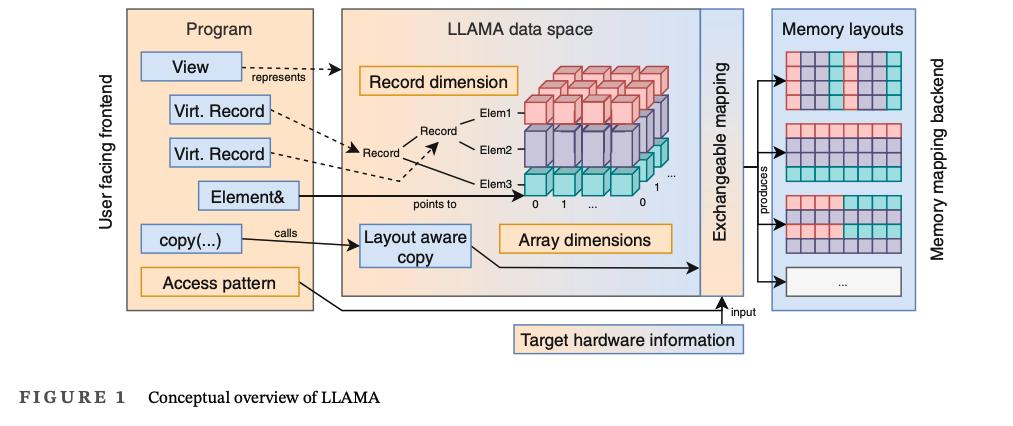Low-Level Abstraction of Memory Access
LLAMA is a cross-platform C++17/C++20 header-only template library for the abstraction of data layout and memory access.
Some points from the paper
The efficiency of parallel programs thus increasingly relies on maximizing data throughput by -
- increasing data locality
- choosing data layouts for efficient parallel access
Specialized compute and memory hardware architectures to fight the increasing gap between compute and memory capabilities:
- Google’s tensor processing units (TPUs)
- the PEZY SC many-core microprocessors
- Fujitsu’s A64FX processor powering the Fugaku supercomputer
- near-memory and in-memory computing architectures
- DRAM modules with additional SRAM caches for their row buffers
Design
The design of LLAMA centers on an abstract description of a data structure containing compile time and runtime information, which is instantiated with a separately configurable memory layout.

Data Space
- In order to separate data structure access and physical memory layout LLAMA introduces an abstract data type called data space.
- The data space is an hyper-cubic index set described by the record dimension and one or more array dimensions
- Record Dimension: The record dimension consists of a hierarchy of names and describes nested, structured data, much like a
structin C++. - Array dimensions: zero-based integral ranges
- Programs are written against this abstract data space, and they are not aware of how that data is actually stored
View and Virtual record
Programs can refer to the data space via a view, and to subparts of the data space via virtual records, which behave like references to structs, to individual elements via real l-value references.
Exchangeable Mapping
- To allow a flexible specification of a memory layout, the data space is materialized via an exchangeable mapping that describes how the index set of the data space is embedded into a physical memory.
- Mapping is exchangeable at compile time
- For further optimization, this mapping can be augmented with additional information from the program’s access pattern and target hardware information.
- Due to a mapping encapsulating the full knowledge of a memory layout, LLAMA supports layout-aware copy operations between instances of the same data space but with different mappings
Describing a data structure
Refer to this web page to see LLAMA equivalent of a similar data structure in C++
Common Software Design Patterns in LLAMA and ADIOS
Both provide Abstraction layer between how we define data structures in our code, to how the data is actually stored in memory / disk
Though ADIOS is for disk IO, and LLAMA is for memory
Both provide custom ways, so that user can define their own data types (ADIOS: Variable, LLAMA: Record)
Both have a feature of (kind of) lazy evaluation. LLAMA delays resolving the actual memory address of a data, while ADIOS uses deferred read/write
LLAMA provides different Mapping techniques between Abstract Layer and Physical memory, while ADIOS provides different Engine types.